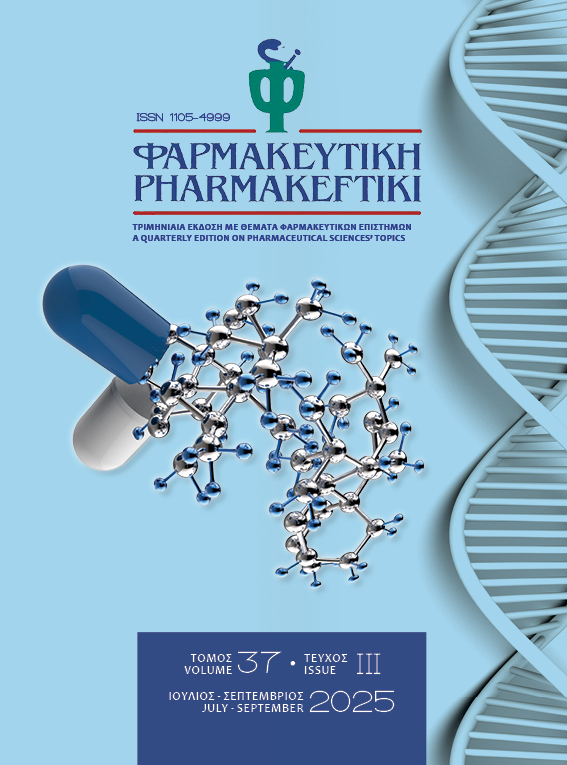The Influence of Hydration Temperature and Lipid Weight in C-4-hydroxy-phenylcalix[4]pyrogallolarene Liposome Preparation as Skin Brightening
DOI:
https://doi.org/10.60988/p.v37i3.63Keywords:
liposome, C-4-hydroxy-phenylcalix[4]pyrogallolarene, L-α-phosphatidylcholine, skin brighteningAbstract
The C-4-hydroxy-phenylcalix[4]pyrogallolarene is a compound proven to inhibit tyrosinase enzyme activity. This activity makes C-4-hydroxy-phenylcalix[4]pyrogallolarene as a potential skin-brightening agent. However, the poor water solubility of this compound limits its application as a skin brightener. Therefore, this study formulated C-4-hydroxy-phenylcalix[4]pyrogallolarene liposomes to address this issue. The liposomes were prepared using the thin-layer lipid film hydration method with L-α-phosphatidylcholine as the lipid base. The resulting C-4-hydroxy-phenylcalix[4]pyrogallolarene liposomes were found in spherical forms, and they exhibited multilamellar vesicle characteristics. This study also examined the influence of hydration temperature and L-α-phosphatidylcholine concentration on liposome size and polydispersity index (PDI). ANOVA analysis using Design Expert-13 indicated that the factors of hydration temperature, L-α-phosphatidylcholine weight, and their interaction all influenced the size and PDI of the resulting C-4-hydroxy-phenylcalix[4]pyrogallolarene liposomes.
References
Lee C. S., Jang W. H., Park M., Jung K., Baek H. S., Joo Y. H., Park Y. H., Lim K. M. A novel adamantyl benzylbenzamide derivative, ap736, suppresses melanogenesis through the inhibition of camp‐pka‐creb‐activated microphthalmia‐associated transcription factor and tyrosinase expression. Exp. Dermatol. 22, 11, 748-774, 2013.
Lim J. H., Park S.H., Kim M. R., Yoo B. S., Yang J. C., Cheong I. W., Kim J. H., Cho J. H. Cyclohexanediol bis-ethylhexanoate inhibits melanogenesis of murine b16 melanoma and uv-induced pigmentation in human skin. Biol. Pharm. Bull. 36, 3, 346-351, 2013.
Lee E. J., Cha H. J. Inonotus obliquus extract as an inhibitor of α-msh-induced melanogenesis in b16f10 mouse melanoma cells. Cosmetics. 6, 9, 1-9, 2019.
Liu X., Rao J., Wang K., Wang M., Yao T., Qiu F. Highly potent inhibition of tyrosinase by mulberrosides and the inhibitory mechanism in vitro. Chem. Biodiversity. 19, 1-13, 2021.
Sukma C. M., Nurhayati A. P. D., Santoso M. In silico analysis of trisindoline 1 as tyrosinase inhibitors. IOP Conf. Ser.: Earth Environ. Sci. 1271, 012084, 1-6, 2023.
Souza P. M., Elias S. T., Simeoni L. A., de Paula J. E., Gomes S. M., Guerra E. N. S., Fonseca Y. M., Silva E. C., Silveira D., Magalhães P. O. Plants from brazilian cerrado with potent tyrosinase inhibitory activity. PLoS ONE. 7, 11, 1-7, 2012.
Jumina J., Kurniawan Y. S., Sari R., Purba S. N. H. B., Radean H., Priatmoko P., Pranowo D., Purwono B., Julianus J., Zulkarnain A. K., Sholikhah E. N. Synthesis and high antioxidant activity of C-alkyl calix[4]resorcinarene and C-alkyl calix[4]pyrogallolarene derivatives. Indonesian J. Pharm. 33, 3, 422-433, 2022.
Pillaiyar T., Manickam M., Namasivayam V. Skin whitening agents: medicinal chemistry perspective of tyrosinase inhibitors. J. Enzyme Inhib. Med. Chem. 32, 1, 403-425, 2017.
Oğuz M., Kalay E., Akocak S., Nocentini A., Lolak N., Boğa M., Yilmaz M., Supuran C. T. Synthesis of calix[4]azacrown substituted sulphonamides with antioxidant, acetylcholinesterase, butyrylcholinesterase, tyrosinase and carbonic anhydrase inhibitory action. J. Enzyme Inhib. Med. Chem. 35, 1, 1215-1223. 2020.
Sturm L., Ulrih N. P. Basic methods for preparation of liposomes and studying their interactions with different compounds, with the emphasis on polyphenols: a review. Int. J. Mol. Sci. 22, 6547, 1-20, 2021.
Pandey S., Verma A., Keshari S. Preparation and characterization of liposomes in novel drug delivery systems: a review. Int. J. Pharm. Sci. Med. 9, 5, 62-73, 2024.
Tsengam I. K. M., Omarova M., Kelley E. G., McCormick A., Bothun G. D., Raghavan S. R., John V. T. Transformation of lipid vesicle into micelles by adding nonionic surfactants: elucidating the structural pathway and the intermediate structures, J. Phys. Chem. B. 126, 2208-2216, 2022.
Kumar A., Gupta M., Braya S. Liposome characterization, applications and regulatory landscape in us. Int. J. Drug Regul. Aff. 9, 2, 81-89, 2021.
Alavi M., Karimi N., Safaei M. Application of various types of liposomes in drug delivery systems. Adv. Pharm. Bull. 7, 1, 3-9, 2017.
Hamid M. S. S., Hatwar P. R., Bakal R. L., Kohale N. B. A comprehensive review on liposomes: as a novel drug delivery system. GSC Biol. Pharm. Sci. 27, 1, 199-210, 2024.
Torres-Martínez A., Angulo-Pachon C. A., Galindo F., Miravet J. F. Liposome-enveloped molecular nanogels. Langmuir, 35, 41, 13375-13381, 2019.
Le N. T. T., Cao V. D., Nguyen T. N. Q., Le T. T. H., Tran T. T., Thi T. T. H. Soy lecithin-derived liposomal delivery systems: surface modification and current applications. Int. J. Mol. Sci. 20, 19, 1-27, 2019.
Doyen C., Larquet É., Coureux P-D., Frances O., Herman F., Sablé S., Burnouf J-P., Sizun C., Lescop E. Nuclear magnetic resonance spectroscopy: a multifaceted toolbox to probe structure, dynamics, interactions, and real-time in situ release kinetics in peptide-liposome formulations. Mol. Pharmaceutics. 18, 7, 2521-2539, 2021.
Serrano G., Almudever P., Serrano J. M., Milara J., Torrens A., Exposito I., Cortijo J. Phosphatidylcholine liposomes as carriers to improve topical ascorbic acid treatment of skin disorders. Clin. Cosmet. Investig. Dermatol. 8, 591-599, 2015.
Weissig V., Liposomes: Methods and Protocols: Pharmaceutical Nanocarriers; Humana Press (Springer Science+Business Media): New York, NY, USA, Volume 1, 564, 2010.
Sumetpipat K., Baowan D. Three model shapes of doxorubicin for liposome encapsulation. J. Mol. Model. 20, 2504, 2014.
Sawant G. S., Sutar K. V., Kanekar A. S. Liposome: a novel drug delivery system. Int. J. Res. 8, 4, 252-268, 2021.
Marchetti M., Vorselen D., Roos W. H., Wuite G. J. L. Detection and mechanical characterization of small multilamellar vesicles using atomic force microscopy. Biophys. J. 110, 3, 2016.
Chaurasiya A., Gorajiya A., Panchal K., Katke S., Singh A. K. A review on multivesicular liposomes for pharmaceutical applications: preparation, characterization, and translational challenges. Drug Deliv. Transl. Res. 12, 7, 1569-1587, 2021.

